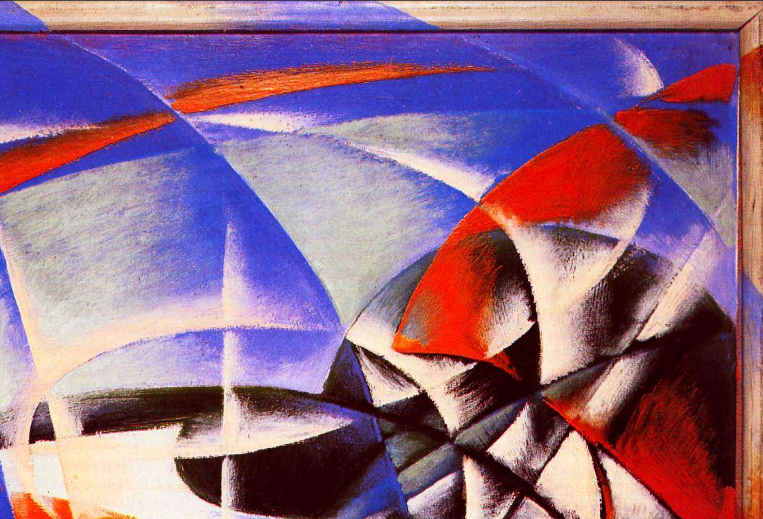
Abstract Speed + Landscape (Velocità astratta + paesaggio) is a painting created by Giacomo Balla in 1913. It is the first (left-most) part of a Triptych of paintings created by Balla which also includes Abstract Speed + Sound (Velocità astratta + rumore) and Abstract Speed – The Car Has Passed (Velocità astratta – l’auto è passata). Abstract Speed + Landscape is painted in the abstract art style and is part of the Futurism art movement. Abstract Speed + Landscape currently resides in a private collection.
Balla was dedicated to researching the phenomenon of movement. He is the author of numerous studies and paintings that examine the dynamism of movement in different forms. The triptych Abstract Speed, which Balla worked on between 1913 and 1914, is an example of a clearly defined futurist aesthetic based on a synthesis of cubist and post-impressionist influences. By contrasting a field of pure colors with very little space for nuanced tones, Balla laid a divisionist basis for the composition. A strong cubist impulse is felt in the application of mobile perspective as well as the geometrical fragmentarity that characterizes all three paintings. The futurist landscape loses the pastoral qualities of traditional landscape painting. It represents the dynamics of movement in nature, whether a landscape is one of the elements of the composition or an independent landscape in the case of aeropainting. In the case of the Abstract Speed triptych, it is about exploring the futurist idea of permeating all living and non-living elements in space. Giacomo Balla painted over frames, thus continuing the space of the painting beyond the space it traditionally occupies. In this way, Balla extracted the scene from the reality of the painting and brought it closer to the viewer.
What is Depicted is Abstract Speed + Landscape
The painting Abstract Speed + Landscape is the first painting of the Abstract Speed triptych. This composition introduces the viewer to the characteristics of the dynamism of the landscape itself just before the appearance of the moving car.
Analysis
The triptych Abstract Speed deals with the dynamism of a car in motion and its interweaving with the landscape that surrounds it. The surface of the ground is separated from the space of the sky by three rounded forms representing hills. In terms of colorism, this composition is based on a double dynamic of contrasting relationships. The first layer of contrast refers to white and black surfaces, while the second is formed by the ratio of warm and cold tones of red and blue. The composition is divided vertically by three clearly visible slightly rounded lines.

In this work, Balla avoided the idea of perceiving the landscape as a spatial framework for action or the landscape as a harmonious oasis. On the contrary, he placed the landscape in the position of a generator of dynamism together with the car that is sensed, that is, later passes and leaves the field of observation. In Manifesto of the Futurist Painters from 1910 Balla together with Umberto Boccioni, Carlo Carrà, Luigi Russolo, and Gino Severini writes :
Living art draws its life from the surrounding environment. Our forebears drew their artistic inspiration from a religious atmosphere which fed their souls; in the same way, we must breathe in the tangible miracles of contemporary life—the iron network of speedy communications which envelops the earth, the transatlantic liners, the dreadnoughts, those marvelous flights which furrow our skies, the profound courage of our submarine navigators and the spasmodic struggle to conquer the unknown.
Related Artworks
Abstract Speed + Landscape is part of a Triptych of paintings created by Balla which also includes Abstract Speed + Sound (Velocità astratta + rumore) and Abstract Speed – The Car Has Passed (Velocità astratta – l’auto è passata)
